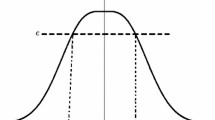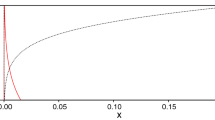Abstract
This paper is concerned with fuzzy hypothesis testing in the framework of the randomized and non-randomized hypergeometric test for a proportion. Moreover, we differentiate between a test of significance and an alternative test to control the type I error or both error types simultaneously. In contrast to classical (non-)randomized hypothesis testing, fuzzy hypothesis testing provides an additional gradual consideration of the indifference zone in compliance with expert opinion or user priorities. In particular, various types of hypotheses with user-specified membership functions can be formulated. Additionally, the proposed test methods are compared via a comprehensive case study, which demonstrates the high flexibility of fuzzy hypothesis testing in practical applications.






Similar content being viewed by others
References
Arnold BF (1996) An approach to fuzzy hypothesis testing. Metrika 44(1):119–126
Arnold BF (1998) Testing fuzzy hypotheses with crisp data. Fuzzy Sets Syst 94(3):323–333
Chukhrova N, Johannssen A (2018a) Generalized one-tailed hypergeometric test with applications in statistical quality control. J Qual Technol (forthcoming)
Chukhrova N, Johannssen A (2018b) Inspection tables for single acceptance sampling with crisp and fuzzy formulation of quality limits. Int J Qual Reliab Manag 35(9):1755–1791
Chukhrova N, Johannssen A (2018c) Fuzzy hypothesis testing for a population proportion based on set-valued information. Fuzzy Sets Syst (revised and resubmitted)
Filzmoser P, Viertl R (2004) Testing hypotheses with fuzzy data: the fuzzy \(p\)-value. Metrika 59(1):21–29
Grzegorzewski P (2000) Testing statistical hypotheses with vague data. Fuzzy Sets Syst 112(3):501–510
Grzegorzewski P (2002) Testing fuzzy hypotheses with vague data. In: Bertoluzza C, Gil MA, Ralescu DA (eds) Statistical modeling, analysis and management of fuzzy data. Physica-Verlag, Heidelberg, pp 213–225
Parchami A, Taheri SM, Mashinchi M (2010) Fuzzy \(p\)-value in testing fuzzy hypotheses with crisp data. Stat Pap 51(1):209–226
Parchami A, Taheri SM, Mashinchi M (2012) Testing fuzzy hypotheses based on vague observations: a \(p\)-value approach. Stat Pap 53(2):469–484
Saade JJ (1994) Extension of fuzzy hypotheses testing with hybrid data. Fuzzy Sets Syst 63(1):57–71
Saade JJ, Schwarzlander H (1990) Fuzzy hypotheses testing with hybrid data. Fuzzy Sets Syst 35(2):197–212
Son JC, Song I, Kim HY (1992) A fuzzy decision problem based on the generalized Neyman-Pearson criterion. Fuzzy Sets Syst 47(1):65–75
Taheri SM, Behboodian J (1999) Neyman-Pearson lemma for fuzzy hypotheses testing. Metrika 49(1):3–17
Taheri SM, Behboodian J (2002) Fuzzy hypotheses testing with fuzzy data: a Bayesian approach. In: Pal NR, Sugeno M (eds) Advances in soft computing—AFSS 2002. Springer, Berlin, pp 527–533
Torabi H, Behboodian J (2007) Likelihood ratio tests for fuzzy hypotheses testing. Stat Pap 48(3):509–522
Torabi H, Behboodian J, Taheri SM (2006) Neyman-Pearson lemma for fuzzy hypotheses testing with vague data. Metrika 64(3):289–304
Zadeh LA (1965) Fuzzy sets. Inf Control 8:338–353
Acknowledgements
The authors would like to thank both anonymous reviewers for their valuable feedback and suggestions, which were important and helpful to significantly improve the paper.
Author information
Authors and Affiliations
Corresponding author
Appendix A: Proofs
Appendix A: Proofs
1.1 A.1 Monotonicity of Q(x) regarding left-tailed crisp case
The probability mass function of a discrete sample random variable X is defined by:
Further, the likelihood ratio can be represented as:
Considering the limit of the likelihood ratio as the population size N approaches infinity we obtain:
Since the second term \(\left[ \frac{\widetilde{p}_{11}(1-\widetilde{p}_{01})}{\widetilde{p}_{01}(1-\widetilde{p}_{11})}\right] ^{x}\) in (A.1) only depends on the realization x of the H(N, M, n)-distributed test statistic X and it holds \(0<\widetilde{p}_{11}<\widetilde{p}_{01}<1\), the likelihood ratio is strictly monotonically decreasing in x. \(\square \)
1.2 A.2 Monotonicity of Q(x) regarding left-tailed fuzzy case
The weighted probability mass function of a discrete sample random variable X is defined for \(p\in \text {supp}(\widetilde{H}_{0})\) and for \(p\in \text {supp}(\widetilde{H}_{1})\) as follows:
Further, the likelihood ratio has the following representation (compare also the proof in Appendix A.1):

Considering the limit of the likelihood ratio as the population size N approaches infinity we obtain

Since \(z_{\alpha }\), \(z_{\beta }\) as also \(w_0(\widetilde{p}_0^*)\), \(w_1(\widetilde{p}_1^*)\) are independent from the realization x, the function Q(x) is in turn monotonically decreasing in x (compare the crisp case). \(\square \)
Rights and permissions
About this article
Cite this article
Chukhrova, N., Johannssen, A. Randomized versus non-randomized hypergeometric hypothesis testing with crisp and fuzzy hypotheses. Stat Papers 61, 2605–2641 (2020). https://doi.org/10.1007/s00362-018-1058-1
Received:
Revised:
Published:
Issue Date:
DOI: https://doi.org/10.1007/s00362-018-1058-1




